NHSScotland Staff Survey 2015 National Report
This National Report provides an overview of the results of the 2015 NHSScotland Staff Survey. The National Staff Survey gives all NHSScotland staff the opportunity to provide feedback on their experience of working for the organisation.
6 Key findings
Overall, the 2015 results indicate around half of the combined positive perceptions are slightly lower when compared with the 2014 results for the 29 comparable top level questions in the 2014 survey. Eight of the questions show no change at all in combined positive responses; 15 show a ‐1% change; two show a ‐2% change and four show positive changes of between 1% and 3%.
In all cases where the combined positive responses (e.g. strongly agree and agree) have increased, the combined negative responses (e.g. strongly disagree and disagree) have also decreased. However, the percentage changes between positive and negative responses may not be equal as a neutral response was also included in the questions/statements response range.
For four of the 29 comparable top‐level questions (asked of all respondents), the results show an improvement in the proportion of staff giving a positive response compared to the 2014 survey results (the improvement is found to be statistically significant for one of these four questions). There was no change in the result for eight top‐level questions. Similarly, one of the fourteen sub‐questions showed an improvement and five showed no change in the proportion giving a positive response. The biggest improvement related to the respondents perception of whether their Board acts fairly and offers equality of opportunity with regard to career progression / promotion showing a 3 percentage point increase in positive response.
The average percentage point change of positive responses have been calculated for questions using the standard five‐point scale in each of the five Staff Governance Standard strands, and for the questions relating to overall experience of working for NHSScotland. It can be seen that the average percentage point change for three strands is ‐1 percentage point or less with no less than 0.5 percentage point change for two strands:
Average changes in experience under Staff Governance Strands (2014‐15)
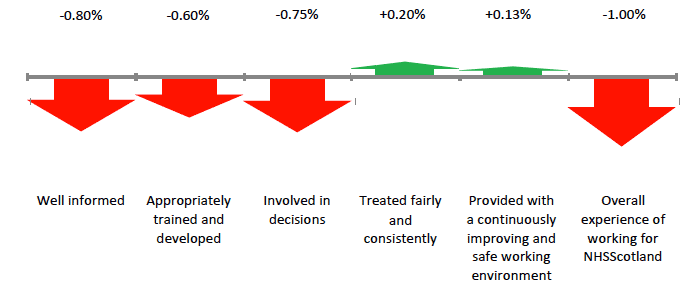
The following tables present the five most positive perceptions from the 2015 survey (Table 1) and the five least positive perceptions (Table 2).
6.1 Most positive perceptions in 2015
Five of the six most positive responses from staff in the 2015 survey are the same as they were in both 2014 and 2013. Q6.7 was included as a new question in 2015 and is also one of the most positive perceptions in 2015.
Of the five questions which could be compared with the 2014 results, the combined positive results for three of these questions show a ‐1% change, one shows a ‐2% change and one showed no change. Of these two are considered a statistically significant change. However, the combined negative response results show no change in perception except for those staff who 'are happy to go the extra mile at work when required', which showed an increase of 1% in the negative responses.
Table 1: The most positive perceptions and their percentage changes on combined positive responses comparing 2014 and 2015 (combined negative responses also shown for completeness):
[These are questions where a high positive score would be a GOOD result]
| Question Number |
Question |
Positive Response % (change on 2014 shown in brackets) |
Negative Response % (change on 2014 shown in brackets) |
||
|---|---|---|---|---|---|
| 6.3 |
I am happy to go the 'extra mile' at work when required |
89% |
(‐1%) |
4% |
(+1%) |
| 1.4 |
I am clear what my duties and responsibilities are |
85% |
(‐1%) |
2% |
(0%) |
| 6.7 (new) |
I have confidence and trust in my direct line manager |
79% |
(NA) |
21% |
(NA) |
| 4.2 |
I get the help and support I need from colleagues |
79% |
(0%) |
6% |
(0%) |
| 6.5 |
I still intend to be working with [Health Board[7]] in 12 months time |
77% |
(‐ 2%) |
7% |
(0%) |
| 1.5 |
I understand how my work fits into the overall aims of [Health Board] |
77% |
(‐1%) |
5% |
(0%) |
Note: All of the questions in the table above except 6.7 used a 5 point response range. The new national question 6.7 mirrors the question used in the NHSScotland iMatter survey, which uses a 6 point response scale, which has no neutral option.
6.2 Least positive perceptions in 2015
The questions/statements attracting the five least positive responses from staff are the same as in 2014. Three of the questions/statements show a ‐1% change on the combined positive responses, with the negative response results for three questions also showing an increase in negative responses between the years as shown in the table below, none are considered a statistically significant change.
Table 2: The least positive perceptions and their percentage changes on combined positive responses comparing 2014 and 2015 (combined negative responses also shown for completeness):
[These are questions where a high positive score would be a GOOD result]
| Question Number |
Question |
Positive Response % (change on 2014 shown in brackets) |
Negative Response % (change on 2014 shown in brackets) |
||
|---|---|---|---|---|---|
| 3.1 |
Staff are always consulted about changes at work |
28% |
(‐1%) |
47% |
(+1%) |
| 5.2 |
There are enough staff for me to do my job properly |
33% |
(0%) |
45% |
(‐1%) |
| 3.4 |
I have a choice in deciding what I do at work |
40% |
(0%) |
25% |
(+1%) |
| 1.3 |
When changes are made at work, I am clear how they will work out in practice |
40% |
(‐1%) |
30% |
(0%) |
| 3.3 |
I am confident my ideas or suggestions would be listened to |
41% |
(‐1%) |
31% |
(+1%) |
Note: All questions in the above table used a 5 point response range. Positive and negative responses are based on combining all relevant responses on the five point response scale.
6.3 Summary results by Staff Governance Standard
Summarised below are the main survey findings in relation to each of the five strands of the Staff Governance Standard and the overall experience of working for NHSScotland.
Well informed
There were five questions/statements in this section of the survey. Four of the five questions showed a ‐1% change on the combined positive response, whilst the question my line manager communicates effectively with me showed no change between 2014 and 2015.
The most positive perception within this strand was for Q1‐4 I am clear what my duties and responsibilities are: 85% of respondents strongly agreed or agreed with this statement.
Appropriately trained and developed
The percentage of staff indicating they have had a KSF development review, performance review, appraisal, Personal Development Plan meeting or equivalent (i.e.74%), showed a change of ‐1% between 2014 and 2015. Those questions then answered by staff who had had a review also showed either a ‐1% change or no change between the years.
Some 84% of those staff who had had a review said they had agreed a Personal Development Plan (PDP) or equivalent. Of those with a PDP, 76% indicated they have received, or expect to receive, the training that was identified in that plan.
Involved in decisions
All but one of the combined positive responses for the questions/statements within this strand of the Staff Governance Standard, changed by ‐1%. Those staff who said they have a choice in deciding what they do at work remained at 40% between the years.
The least positive perception for this strand was for Q3‐1 Staff are always consulted about changes at work (28%). Some 53% agreed that they have sufficient opportunities to put forward new ideas or suggestions for improvement in their workplace.
Treated fairly and consistently, with dignity and respect in an environment where diversity is valued
The largest improvement to a question/statement in the overall staff survey is found under this Staff Governance Standard, i.e. [Health Board[8]] acts fairly and offers equality of opportunity with regard to career progression/promotion. In 2015, 62% of staff had a positive perception of this statement compared to 59% in 2014 and 44% in 2013, showing an overall 18% increase since 2013.
The percentage of staff saying they have experienced unfair discrimination from their manager or other colleagues in the last 12 months has seen a 1% change for both questions, increasing the percentages who indicate they have experienced it to 7% and 8% respectively.
Although the percentage of staff reporting this unfair discrimination fell by 1% to 34%, those staff who were satisfied with the response they received as a result of reporting it improved between the years by 3% to 29%.
Provided with a continuously improving and safe working environment promoting health and wellbeing of staff, patients and the wider community
This section of the survey had the most variation of change in results for the questions/statements included, with three questions showing a positive change, three showing negative change and two with no change between the years.
There was an improvement of 1% of staff with combined positive perceptions of the question I can meet all the conflicting demands on my time at work on the 2014 perception, and a lower percentage of staff indicating they had experienced bullying/harassment from their manager (‐1%) or from other colleagues (‐2%) for the second year running.
Overall experience of working for NHSScotland
The results in this section of the survey had the two questions in the overall survey which showed a ‐2% change on the 2014 combined positive responses. These were related to the percentage of staff who responded positively to the question/statement I would recommend my workplace as a good place to work saw a change from 61% in 2014 to 59% in 2015; and those staff who still intend to be working with their Health Board in 12 months time reduced from 79% to 77% in 2015.
Two additional national questions were included in the 2015 survey which match those used in the NHSScotland iMatter survey. One of the questions i.e. I have confidence and trust in my direct line manager was one of the most positive perceptions included in the survey in 2015 with 79% of staff agreeing with the statement.
6.4 Main changes: 2014 to 2015
Overall, the 2015 results indicate around half of the combined positive perceptions are slightly lower when compared with the 2014 results for the 29 comparable top level questions in the 2014 survey. Eight of the questions show no change at all in combined positive responses; 15 show a ‐1% change; two show a ‐2% change and four show positive changes of between 1% and 3%.
In cases where the combined positive responses (e.g. strongly agree and agree) have changed, the combined negative responses (e.g. strongly disagree and disagree) may also have changed. However, the percentage changes between positive and negative responses may not be equal as a neutral response was also included in the questions/statements response range.
It should be noted that the following tables show increases and decreases in percentage terms and do not necessarily mean these are statistically significant differences between the years.
Table 3a: Table of questions with percentage increases on combined positive responses comparing 2014 and 2015 (combined negative responses also shown for completeness):
[These are questions where a high positive score would be a GOOD result]
| Question Number | Question |
Positive Response % (change on 2014 shown in brackets) |
Negative Response % (change on 2014 shown in brackets) |
||
|---|---|---|---|---|---|
| 4.3 | [Health Board[9]] acts fairly and offers equality of opportunity with regard to career progression/promotion |
62% |
(+3%) |
13% |
(‐2%) |
| 5.1 | I can meet all the conflicting demands on my time at work |
46% |
(+1%) |
33% |
(‐1%) |
Note Q4.3 and 5.1 used a 5 point response range which included a neutral option
Table 3b: Table of questions with percentage decreases on combined negative responses comparing 2014 and 2015 (combined positive responses also shown for completeness):
[These are questions where a low negative score would be a GOOD result]
| Question Number | Question |
Positive Response % (change on 2014 shown in brackets) |
Negative Response % (change on 2014 shown in brackets) |
||
|---|---|---|---|---|---|
| 5.5 | During the last 12 months while working for your health board have you experienced harassment and bullying from your manager? |
92% |
(+1%) |
8% |
(‐1%) |
| 5.6 | During the last 12 months while working for your health board have you experienced harassment and bullying from other colleagues? |
87% |
(+2%) |
13% |
(‐2%) |
Note Q5.5 and 5.6 used Yes/No responses
Table 3c: Table of largest percentage decreases on combined positive responses comparing 2014 and 2015 (combined negative responses also shown for completeness):
[These are questions where a high positive score would be a GOOD result]
| Question Number | Question |
Positive Response % (change on 2014 shown in brackets) |
Negative Response % (change on 2014 shown in brackets) |
||
|---|---|---|---|---|---|
| 6.4 |
I would recommend my workplace as a good place to work |
59% |
(‐2%) |
16% |
(0%) |
| 6.5 |
I still intend to be working with my health board in 12 months time |
77% |
(‐2%) |
7% |
(0%) |
Note Q6.4 and 6.5 used a 5 point response range which included a neutral option
Figure 2 shows the percentage of positive responses to each attitudinal question (ordered from most to least positive), with percentage change from 2014 also listed except for the two new questions added to this year. It should be noted the figures show increases and decreases in percentage terms and not statistically significant differences between the years.
Figure 3 shows the percentage point change from 2014 of positive responses to each question (ordered from most to least improved) and colour coded statistical significance.
Figure 2 ‐ Percentage of positive responses to each attitudinal question in the NHSScotland Staff Survey 2015 (ordered from most to least positive result)
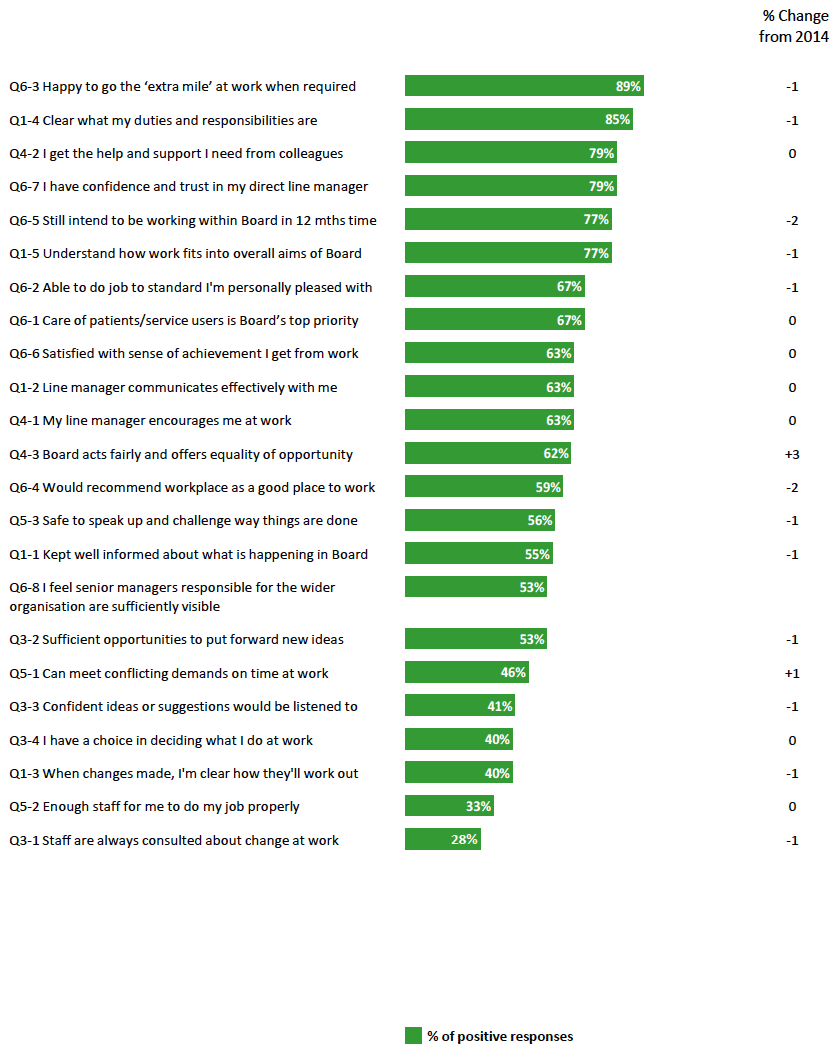
There may be variation up to 1% when compared to the Frequency Data due to rounding.
Figure 3 ‐ Percentage change in positive responses to each question in the NHSScotland Staff Survey between 2015 and 2014 (ordered from most to least positive percentage change)
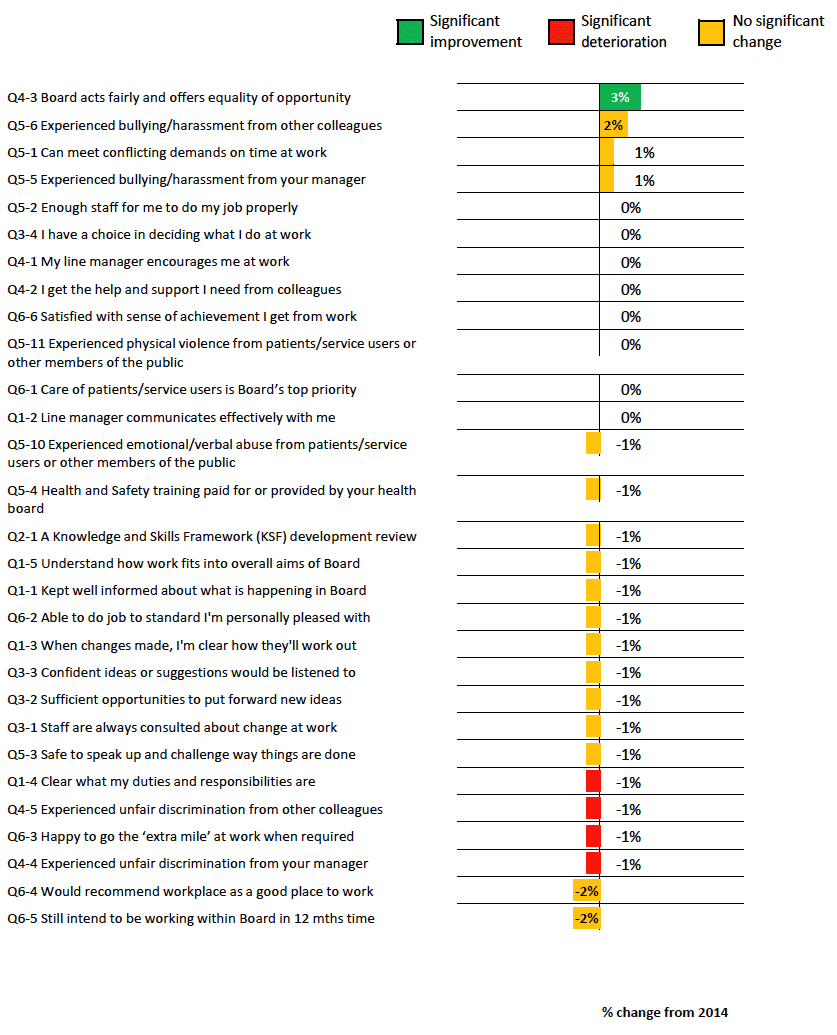
6.5 Identifying opportunity for improvement across NHSScotland
This part of the report displays all primary questions in the survey compared to the results in 2014, but excludes sub set or secondary questions. Table 4 below contains the full question text; the 2015 percentage; the 2014 percentage; and the percentage change between the two years. (Due to rounding, the percentage difference may appear to be 1 percentage point different to the figure that would be obtained by simply comparing the rounded percentages for the two years).
Where questions are negatively worded the positive perception is shown to enable the ranked order to be determined e.g. The results for the question: During the past 12 months while working for your health board, have you experienced unfair discrimination from your manager? are displayed for those who said NO to this question i.e. in the example below, 7% of staff said they felt they had experienced unfair discrimination from their manager, therefore this is displayed as 93%. The text of these questions is highlighted in grey in the table.

The 2015 question results are in a descending ranked order i.e. the most positive responses appear at the top of the list. The 2014 results are displayed alongside the 2015 rankings and both sets of results are colour coded to help to identify areas of strength or improvement.
The cell containing questions results are colour coded Red, Amber or Green according to the percentage of respondents giving a positive response:
-
 indicates 'strength'‐ agreement from 65% or more of staff
indicates 'strength'‐ agreement from 65% or more of staff -
 indicates 'opportunities for improvement' ‐ agreement from between 41% and 64%
indicates 'opportunities for improvement' ‐ agreement from between 41% and 64% -
 indicates 'areas for improvement' ‐ agreement from 40% or fewer staff.
indicates 'areas for improvement' ‐ agreement from 40% or fewer staff.
The parameters for the 'red', 'amber' and 'green' colour coding have been set by Capita for this survey in line with the parameters used in analysis of the results of other public sector staff surveys. When using a 5‐point scale the cut‐off for 'areas of strength' is usually questions or statements generating an average score of over 4.00 on a scale of 1 to 5. Analysis of the national survey data informed the conversion of the threshold for 'areas of strength' to questions or statements where 65% or more strongly agree or agree.
Similarly, the cut‐off for 'areas for improvement' is usually questions or statements generating a score below 3.00 (mid‐point on the scale from 1 to 5) and this is converted into 40% or fewer staff agreeing.
The red/amber/green colour coding is designed to act as a guide to interpreting the results and to help to identify areas of strength and areas that present opportunities for improvement.
Further explanation of this is provided in the Technical Report.
The coloured text in the third column highlights where there has been a change in perception between the years. The summary table of improvements, no significant change or deteriorations between the years shown below is shown at the top of each table.

Only statistically significant differences are presented in green or red font. Where a zero or a small, but not statistically significant change, has occurred the percentage agreeing, NSC (no significant change) is shown in amber font.
Table 4 shows the percentage of respondents who gave positive responses to the question
Responses to negatively‐phrased questions (highlighted in grey) have been treated in reverse to allow direct comparison with positively‐worded questions. e.g. 'Q4‐5 During the past 12 months while working for my health board, have you experienced unfair discrimination from other colleagues?', the percentage stated represents the respondents who said 'No' to that question (i.e. gave the positive response).
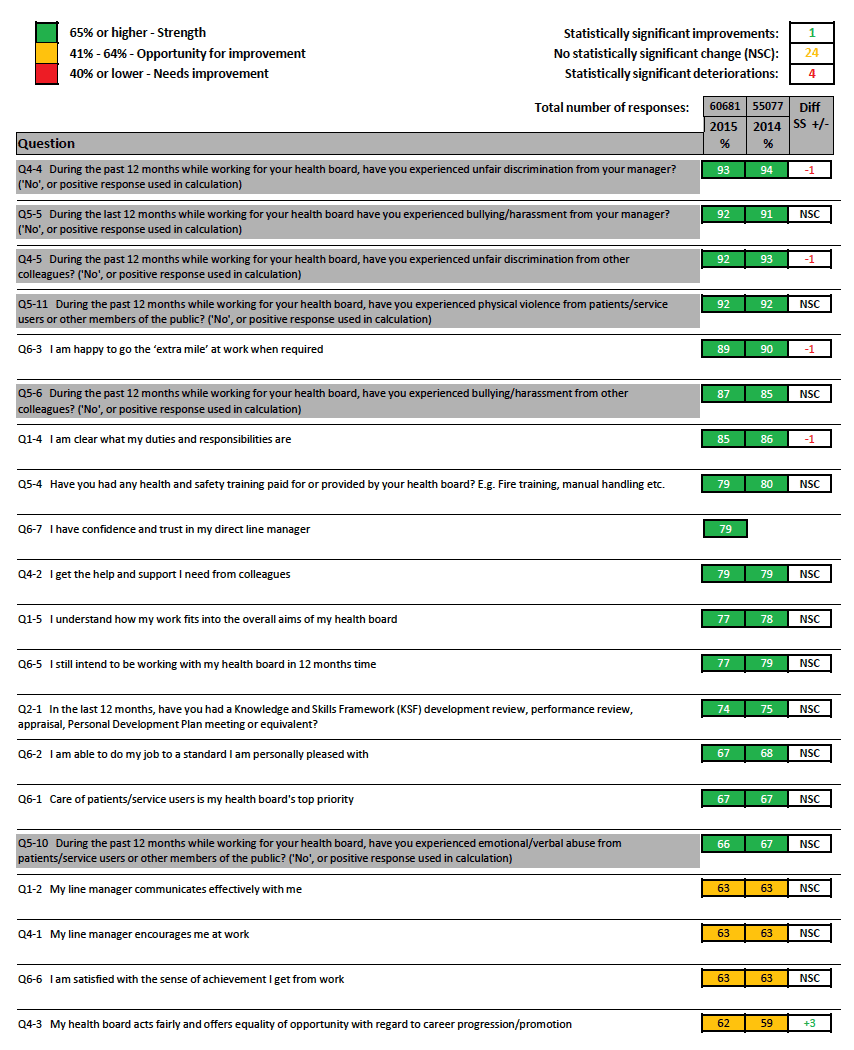
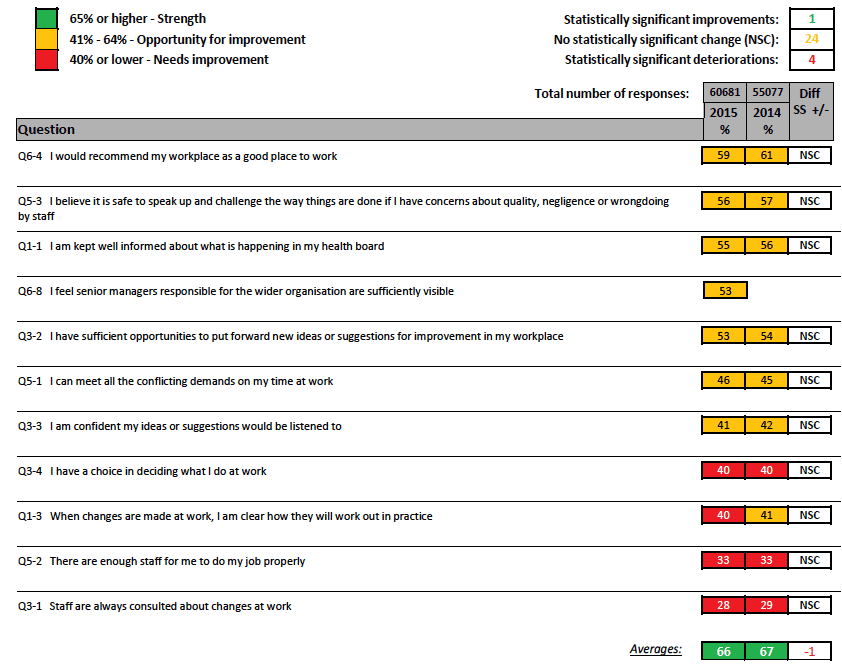
There may be variation up to 1% when compared to the Frequency Data due to rounding.
Contact
Email: Malcolm Summers
There is a problem
Thanks for your feedback